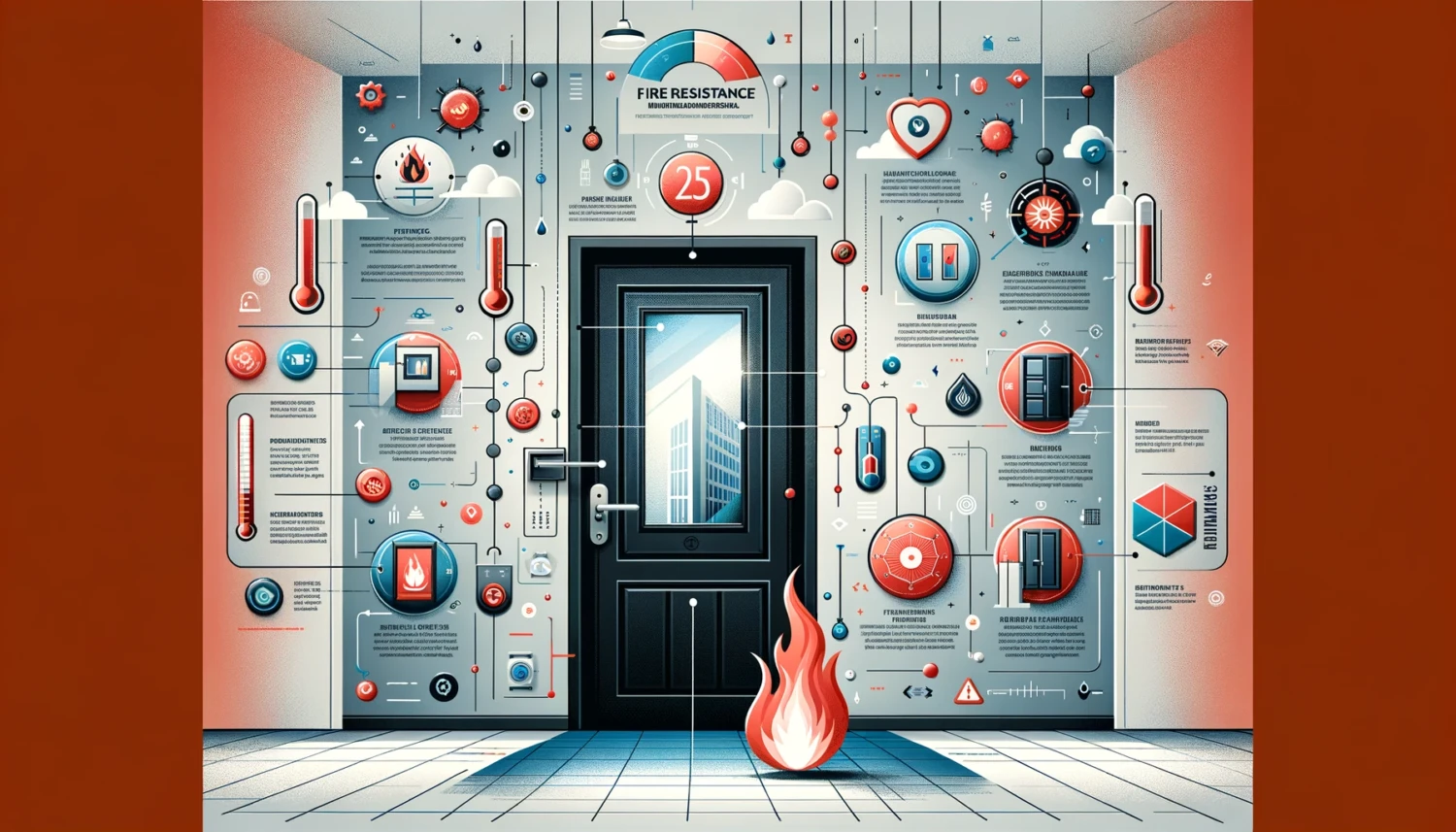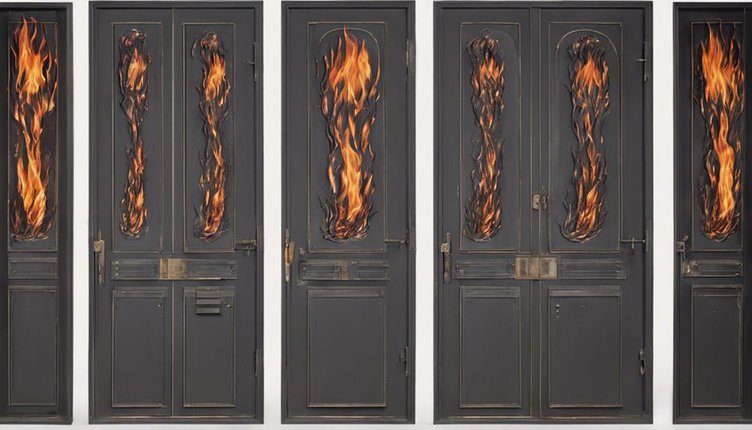Fire rated doors offer varying levels of fire resistance to protect you in case of a fire. Each type provides a different duration of protection, with FD30, FD60, FD90, and FD120 offering increasing levels of resistance.
Choose the type that best suits your needs to ensure maximum safety in your building.
Key Takeaways
- Fire rated doors, FD30, FD60, FD90, and FD120, provide varying levels of fire resistance, crucial for safety in different settings.
- The choice of fire door depends on fire risk assessment, aesthetic needs, space requirements, and compliance with fire safety regulations.
- Regular maintenance of these doors, focusing on seals, hardware, and alignment, is vital to ensure their functionality during emergencies.
- Neglecting the upkeep of fire doors can compromise safety and violate regulatory standards, emphasizing the importance of regular inspections.
Understanding Fire Rated Doors
Often, understanding fire rated doors – such as the FD30, FD60, FD90, and FD120 – is key to choosing the right level of fire protection for different environments. These doors, crafted from diverse fire door materials like steel, timber, or glass, provide protection ranging from 30 to 120 minutes. The choice in material isn’t merely aesthetic; it impacts the door’s performance during a fire.
Fire door regulations are stringent, ensuring that these doors meet specific standards of fire resistance. These regulations govern everything, from the materials used to the door’s installation and maintenance, ensuring optimal performance when it’s needed the most.
Speaking of maintenance, fire door maintenance is crucial. Periodic checks for signs of wear and tear, ensuring seals are intact, and that the door closes correctly are all part of a regular maintenance routine. This ensures the door’s integrity and, by extension, the safety of the building’s occupants.
Features of FD30 Fire Doors
In the realm of fire safety, FD30 fire doors stand as a popular choice, particularly in residential properties, due to their ability to provide 30 minutes of fire resistance during emergencies. These doors, typically 44-45mm thick, are designed specifically to help contain and slow down the spread of fire, playing a vital role in your emergency protection plan.
Now, let’s delve into the key features of FD30 fire doors:
- Fire Resistance: As their name suggests, FD30 doors offer 30 minutes of fire resistance. This allows sufficient time for the building’s occupants to evacuate safely.
- Compliance with Building Regulations: These doors are a cost-effective solution to meet fire safety regulations. They’re often required in buildings to ensure a minimum standard of fire safety.
- Construction: FD30 doors are robust and durable, built to withstand intense heat. Their thickness contributes to their ability to slow down the spread of fire.
Benefits of FD60 Fire Doors
While FD30 doors are a solid choice for many residential properties, you’ll find that FD60 fire doors offer an even greater level of protection, especially in high-risk areas. These doors are designed to provide 60 minutes of fire resistance, effectively doubling the protection offered by FD30 doors. This longer protection can make all the difference in a fire situation, granting occupants more time to evacuate and firefighters an extended window to control the fire.
In terms of enhanced safety, FD60 fire doors are thicker and more robust, designed to withstand high intensity fires. This built-in resilience ensures that fire and smoke are contained for longer periods, mitigating the spread of fire and potential damage.
Commercial applications of FD60 doors are widespread, given the higher risk environments often found in these settings. They’re ideal for buildings with specific fire safety regulations requiring longer fire resistance. Choosing FD60 fire doors for your business signifies a commitment to safety, demonstrating that you’re not only meeting regulations but prioritising the well-being of people within your premises. It’s a smart investment that intertwines innovation, safety, and regulatory compliance.
FD90 Fire Doors Explained
Pushing the boundaries of fire safety, FD90 fire doors offer a whopping 90 minutes of fire protection, standing up to intense heat and flames with their robust design. The FD90 is an innovation in fire door construction, combining both durability and advanced fire resistance capabilities.
- Fire door construction: The FD90 is built thicker and stronger than standard fire doors. The design and materials used ensure it can endure extreme temperatures, providing reliable fire protection.
- Fire door applications: You’ll typically find FD90 doors in high-risk areas demanding extended fire protection. Industrial settings and high-rise buildings are common places you’d see these doors, ensuring safety for a longer duration during a fire.
- Fire door durability: The durability of FD90 doors is unmatched. They’re designed to stand the test of time, and more importantly, the test of fire.
In essence, the FD90 pushes the limit of how fire doors can enhance safety. It’s not just about meeting standards, it’s about exceeding them. With FD90 doors in your building, you’re not just investing in a door, but a promise of increased safety.
Benefits and Features of FD120 Fire Doors
Taking fire safety to an even higher level, consider the remarkable FD120 fire doors, designed to offer an impressive 120 minutes of fire protection. These doors aren’t just a part of building regulations; they’re an integral aspect of emergency preparedness, especially in high-risk settings.
FD120 doors are engineered to withstand intense heat and flames for an extended period. This significantly increases the time available for evacuation and firefighting efforts, reducing the risk of structural damage and loss of life. It’s not just about meeting standard requirements; it’s about exceeding them, providing a higher level of protection in extreme fire scenarios.
The importance of these doors can’t be overstated. They offer enhanced fire safety measures that are critical in buildings where a longer fire resistance duration is required for maximum safety. Investing in FD120 fire doors isn’t just about compliance; it’s about prioritizing safety and reliability in a world where innovation is key. Their superior fire resistance is a testament to how far fire safety technology has come, and their role in saving lives and property is invaluable.
Choosing the Right Fire Door
Navigating the world of fire doors may seem complex, but understanding the fire rating requirements can help you select the right FD30, FD60, FD90, or FD120 fire door for your specific application. It’s not just about safety standards, but also about matching your fire door selection to the design and aesthetic needs of your space.
When it comes to fire door applications, industry requirements dictate what level of protection you need. Consider these points:
- Assess the Risk: Understand the potential fire risk in your building. A high-risk area might necessitate an FD90 or FD120 door, while lower-risk areas could be well-served by an FD30 or FD60 door.
- Evaluate Design: Fire door aesthetics matter too. You don’t have to compromise on design for safety. Today’s market offers fire doors in a variety of styles and finishes.
- Compliance is Key: Ensure your fire door selection meets local fire safety regulations. Non-compliance can lead to serious consequences.
Installation Tips for Fire Doors
Once you’ve chosen the right fire door for your specific needs, it’s crucial to install it correctly to ensure its effectiveness in case of a fire. Installation challenges can arise, including incorrect alignment and clearance, which can impede its operation. To combat this, verify that the door is properly aligned with the frame, ensuring a clearance of approximately 3mm.
Common mistakes often include improper installation of intumescent seals. These seals, located around the edges of the door, expand when exposed to high temperatures, blocking the gap between the door and frame. Make sure they’re correctly installed to maintain the door’s integrity during a fire.
Another vital aspect is the hardware installation. Follow the manufacturer’s guidelines closely to avoid compromising the door’s fire resistance capabilities. Incorrectly installed hardware can significantly reduce the door’s effectiveness.
Maintenance of Fire Rated Doors
In maintaining your fire rated doors, regular inspections and upkeep are critical to ensure they function properly during emergencies. Your focus should be on three main aspects: intumescent seal inspection, hardware maintenance, and gap checking and alignment.
- Intumescent Seal Inspection: The intumescent seal is a key component that expands in the face of heat, preventing smoke and fire from spreading. Regularly inspect for any signs of damage or wear and replace if necessary.
- Hardware Maintenance: The door’s hardware, including hinges, handles, and closing mechanisms, must be in top-notch condition. Damaged or worn hardware can impede door functionality. Regularly oil moving parts and replace any defective components promptly.
- Gap Checking and Alignment: Ensure the door is correctly aligned within its frame; improper alignment can create gaps, reducing the door’s effectiveness in a fire. Regularly check the door for any gaps around the edges and rectify them immediately.
Frequently Asked Questions
What Are the Requirements for a Fire-Rated Door?
You’ll need to follow strict installation processes, ensure regular maintenance, and meet specific compliance standards when installing a fire-rated door. It’s crucial these doors meet the required fire resistance for optimal safety.
What Doors Have to Be Fire-Rated?
You’ll need fire-rated doors for high-risk areas like stairwells and exits. Consider door materials, the installation process, and maintenance guidelines to ensure they’re up to standard. It’s not just about installing, but also preserving their efficiency.
What Makes a Door Fire-Rated?
You’re making a door fire-rated by using specific materials, following precise installation procedures, and adhering to regular maintenance. It’s not just the door, but the entire assembly that’s designed to withstand fire for a set period.
How Do You Check if a Door Is Fire-Rated?
To verify if a door’s fire-rated, check for door labeling or certification marks. Also, examine installation techniques and regular maintenance practices. Refer to manufacturer’s specs or consult experts if you’re uncertain.





